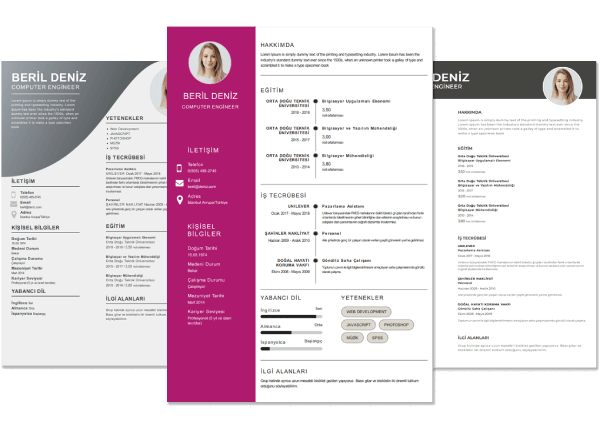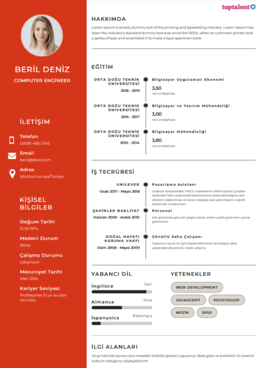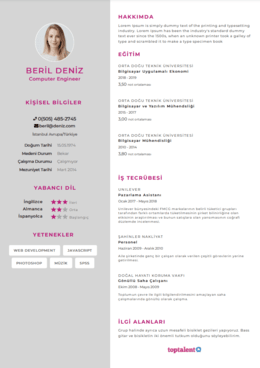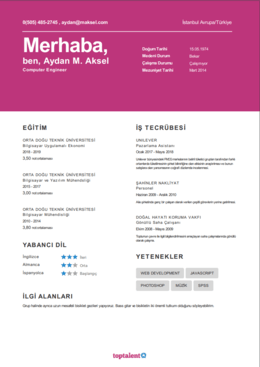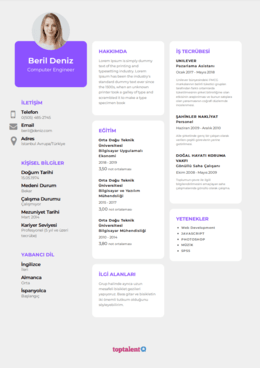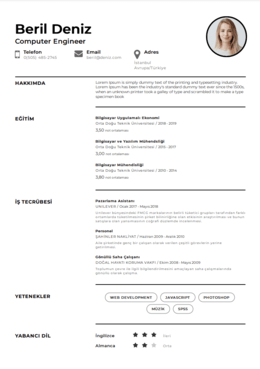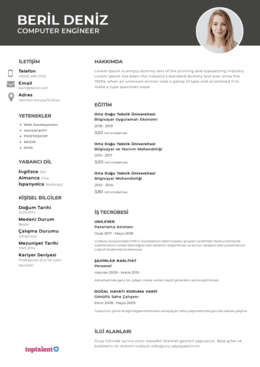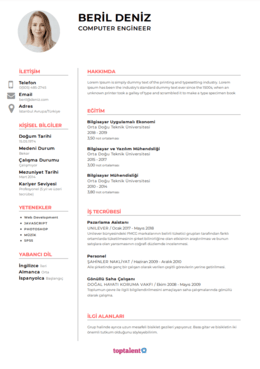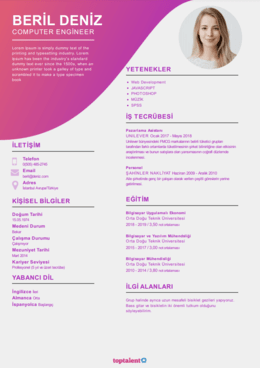Resume Help Ahmet Alperen Polat
Resume Paper: Best Types, Colors & Brands to Choose
Yeni CV örneklerini inceleWe're ready to share our opinion of the top resume paper with you. First, though
Most of the time, sending a digital resume and cover letter is all that is required to apply for a job. Do you ever require a printed copy?
Yes.
Career fairs and job interviews are the two occasions when you must have a paper resume on hand. Both can be quite important to your employment search.
So you only need to click print to be ready to go, right?
Anything but. You require a certain resume paper.
1. What is a resume paper?
The type of paper known as "resume paper" is made specifically for printing cover letters and resumes. Choose a paper with a weight of about 32 lb. and a content of 75–100% cotton for the best quality. For job interviews and career fairs, bring a printed copy of your resume on high-quality paper.
And why is it crucial?
Because a recruiter or potential employer will form their initial impression of your resume based on the sort of paper you utilize. Bad resume paper will give you a schlumpy, slouchy appearance. Who would want to employ someone like that?
In turn, using a quality resume paper will demonstrate your professionalism and attention to detail.
So—
Which resume paper works the best?
If you're only interested in the bottom line:
The finest resume paper is 32 pounds of 75 to 100 percent cotton.
And we have nothing but pleasant feelings about this decision.
Additionally, here is our opinion on the specifics of the ideal resume paper:
- The most elegant and posh resume paper is ivory or granite.
- The most secure and common choice is white, simple resume paper.
But why do you think you'd decide to believe us?
See for yourself as you scroll!
To assist you in selecting the resume paper that best suits your preferences and needs, we have printed up sample resumes on more than 10 different types of resume stationery.
Let's examine the effects of various resume paper kinds on how our resumes print out now.
2. Resume Paper Color: White vs. Ivory Resume Paper
The first conundrum you'll probably encounter is whether to choose ivory or white resume paper.
Let's examine how the color of the paper affects how our three templates appear:
Resume Template "Crisp"
Our "Crisp" template is quite straightforward. There aren't too many graphics or colors. A simple résumé like this can be printed on ivory paper to offer a beautiful, refined touch without worrying about legibility.
Conclusion: Despite the fact that it was a close race, the ivory paper won the day.
Resume Template "Cascade"
There are two contrasting columns in "Cascade." Compared to the previous template, it has more color but less shading. Again, ivory paper has a really polished appearance and can showcase your uniqueness. Regardless of the paper color you choose, the dark column will appear fine if you have a high-quality printer.
The score is 2:0 in favor of ivory paper.
Resume Template "Cubic"
Like "Cascade," "Cubic" displays certain information in a side column. The distinction? The column has a pale hue. On white resume paper, this subtle grey tinting looks great.
Verdict: In this comparison, white paper prevails.
Conclusion: The Best Resume Paper Color
- Your resume will appear formal and tasteful when printed on ivory paper if it only uses dark, consistent colors and white space.
- A white paper is an ideal choice for resumes with light tones.
3. Resume Paper Weight: 20 lbs vs. 24 lbs vs. 32 lbs Resume Paper
You've chosen the color of the resume paper that works best for you.
So—
Right now, all you have to do is print your resume on a piece of paper that matches your preferred color scheme.
Wait a minute.
The paper weight of your printed resume is another element that affects how it appears:
There are typically three choices available: 20, 24 or 32-pound resume paper.
Which resume paper weight is best? 32 lbs.
It shows through the least. It is also the brightest and whitest. Additionally, it is the most stable of the three and is less likely to collapse.
Finally, the feel of a 32-pound resume paper is incredibly pleasant. There is just something unique about it.
Conclusion: The Ideal Resume Paper Weight
This contest is won with 32 pounds of resume paper without a doubt. Highly suggested for all resumes.
4. Resume Paper by Texture
Next, we look into the texture of resume paper.
Think it is unimportant?
Look at that. The degree to which the texture of a resume paper can vary will surprise you!
We chose the "Crisp" and "Cascade" templates for this comparison in order to best illustrate how texture affects how a resume appears.
Plain Resume Paper
A safe option is always plain paper. Every business uses this type of paper since it is the most prevalent.
The simple resume paper in the image above is 100% cotton; the high cotton content gives the otherwise uninteresting plain resume paper some texture and added softness. Read on to learn more about the significance of cotton content for resume papers.
View examples of other resume formats on this particular resume paper texture:
Here is a helpful table outlining the key benefits and drawbacks of utilizing plain resume paper:
PROS
- Will be compatible with any resume design
- Hardly any possibility of ink splashes
- Ordinary and customary
CONS
- Unoriginal—won't stand out
- 'Premium' quality absent
Parchment Resume Paper
All about that Old World grace is parchment paper.
Historically, parchment paper has always been used to write or print any important papers, including invitations from the government, rewards, and certificates.
It is lovely. But it's also a little pretentious.
Some employers could be impressed by a parchment paper résumé, while others might be put off by it. "Hey, Stephanie, was this brought by carrier pigeon or a person on a high-wheeler?"
Please take note that the ivory parchment paper we chose for this comparison. Sometimes the ivory parchment paper may have a finish that is greenish and gray.
Long story short, once more:
PROS
- Some would say really classy and elegant
- Unusual could make your resume stand out
CONS
- Inconsiderate to others
- Need ink and a top-notch printer.
Granite Resume Paper
Granite resume paper strikes the ideal blend between classic elegance and novelty.
This resume paper's texture is quite pleasant to the touch and will clearly display all visual and text elements.
PROS
- Well-balanced—simple but creative
- Environmentally friendly—granite paper is typically produced using recycled materials
- Suitable for all printer kinds
CONS
- Light-colored elements or shades may only be barely discernible because it is slightly darker than other paper texture kinds.
Laid Resume Paper
A laid finish is applied to the paper to replicate the appearance of the first paper. The chain lines pattern is imprinted into the paper during the manufacturing process using a handy roll. Although incredibly refined and distinctive—
Avoid it if your resume has a lot of ink-intensive dark-colored parts or if your printer isn't of the highest caliber.
The resume paper texture that is most likely to result in printing mistakes is laid paper.
PROS
- Sophisticated and distinctive
- Feels great to touch.
CONS
- Error-prone while printing
- One of the priciest kinds of paper textures
5. Resume Paper by Cotton Content—Comparison
The twist is this:
The aforementioned similarities may all be worthless. It's time to discover the true game-changer:
contains cotton.
Possibly the most significant quality of the excellent paper. Cotton composition affects:
- Paper longevity
- Depth and richness of color
- Cotton paper has a sharp, yet soft, texture compared to regular wood pulp paper.
Paper gets a tiny bit of roughness from cotton content, as I indicated earlier. As a result, cotton paper (on the left in the image) does not reflect light.
High cotton content improves the fonts and ensures that the colors on your printed resume more accurately match the colors in your digital copy.
You won't be able to see one more difference, though, because the cotton paper is quite soft when you touch it.
So—
It's about time we declared our final choice for the finest resume paper now that we have all these samples and data, don't you think?
Not exactly.
Personal tastes, followed by science and factual information—
6. What Type of Resume Paper is Best According to Recruiters?
This study examined the effectiveness of resumes that were otherwise comparable in terms of layout (formal vs. creative) and paper (white vs. colorful).
- The formal MS Word resume format printed on white paper had the best results, with 41% of the members of the evaluation group accepting applicants who had this resume format.
- Official resume printed on pink, pale green, or yellow paper? Only 32% of respondents said they would accept these candidates, and 32% said they would automatically reject them.
- The worst of the three was the creative résumé on white paper, which received 42% immediate rejections.
The message is clear: white paper is the safest option, and unusual resume paper color will hurt your chances of finding a job. However, the ivory paper was not included in the study.
Another intriguing study revealed that more than 1 in 5 recruiters would flat-out reject an applicant whose CV was printed on ornamental paper.
Otherwise, put—
For a resume, a textured, business paper is acceptable. The use of artistic decorative paper will defeat your employment search.
Also, just in case you were curious...
7. What’s the Best Resume Paper Size?
The standard 8.5 x 11in. Story over.
You're partially correct if you believe that using a non-standard resume paper size will help your application stand out.
However, in this context, "stick out" would indicate "not fit." Additionally, when it doesn't fit, it is discarded.
Right—
Now that you know a lot about the best paper to print a resume on, let's move on. You have your first choice.
Time to hit the shops!
8. Where to Buy Resume Paper?
You can choose from a few options:
- You can go to your neighborhood bargain retailers like Walmart or Target for plain, white resume paper.
- Try professional office supply retailers like Staples or Xero copy stores, like FedEx Office, if you want a better resume paper.
- If you've already made up your mind on the paper you'll use for your resume, you may purchase it online.
As you can see, you have several options.
Let your creativity run wild when creating your resume!
Key Takeaway
Does the type of resume paper you choose make a difference? It absolutely does. You have personally witnessed the magnitude of the difference.
- Never forget to bring a hard copy of your CV to career fairs and job interviews.
- Employers will have a favorable first impression of you if you print your resume on resume paper of high quality.
- We recommend either ivory, 32 lb., granite, 75-100 % cotton resume paper, or white, 32 lb., plain, 75-100 % cotton resume paper.
But—
Choose the paper kind that you prefer most!
Last but not least, keep in mind that while your choice of resume paper is quite significant, the substance of your job application is what matters most.
